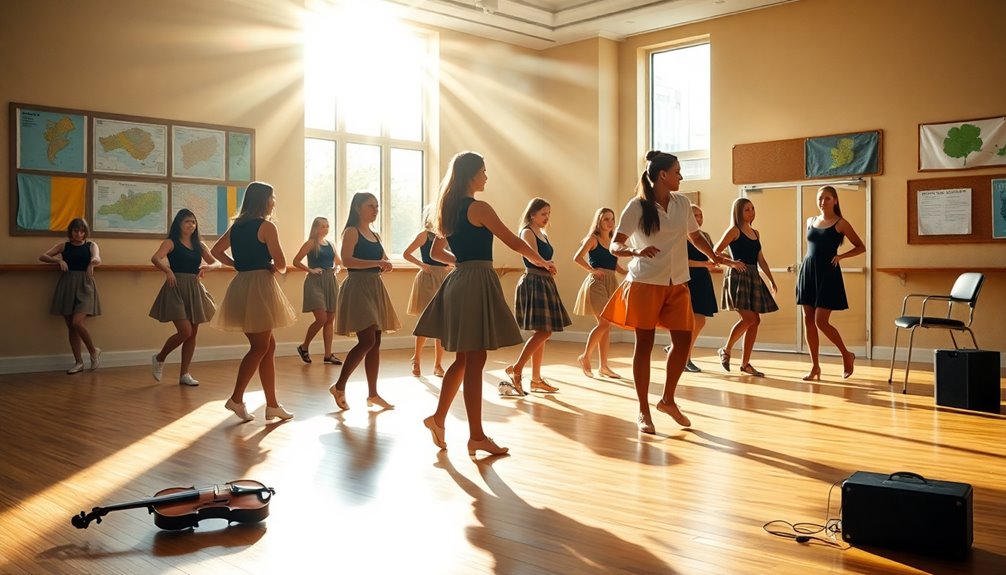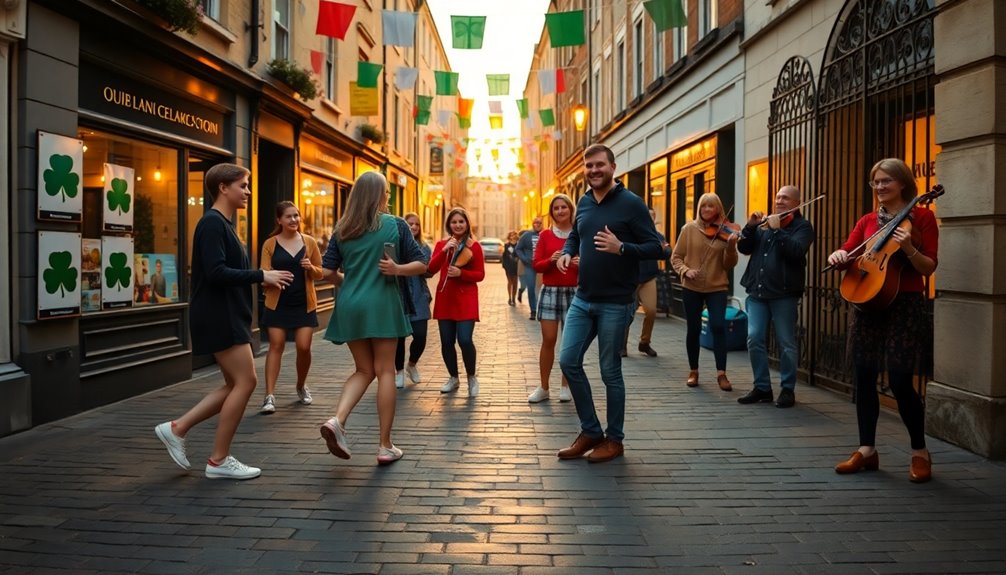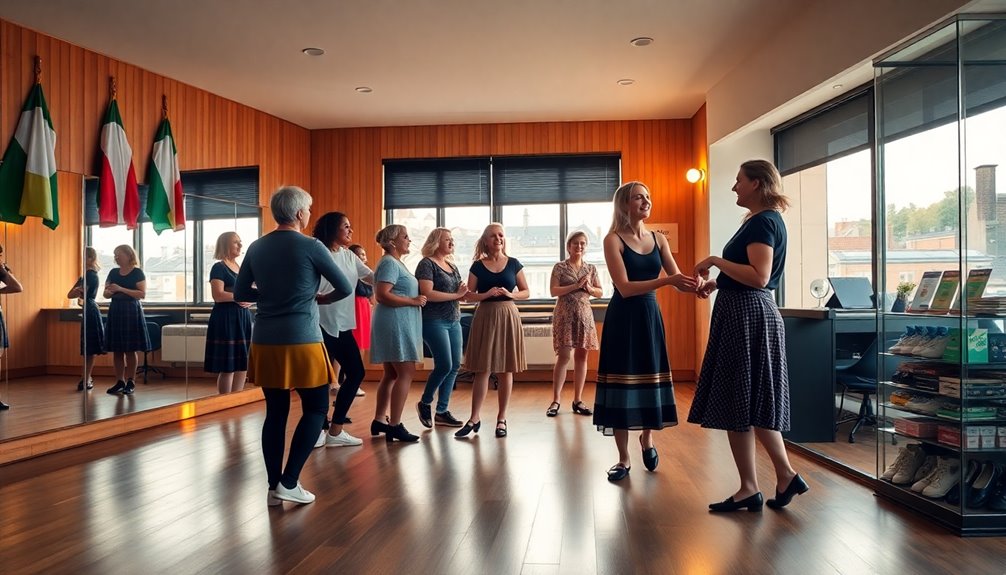
Looking for language schools that pair Irish dance with lessons? You’ll find programs that use step, rhythm, and song to teach vocabulary, pronunciation, and cultural stories. Pick schools with qualified instructors, clear level progression, and flexible schedules—many offer workshops, multi-week courses, or intensives that mix drills with creative practice. Bring comfy clothes and soft shoes, and expect a friendly, performance-focused community. Keep going to get tips on choosing schools, costs, and how classes are structured.
Highlights
- Search for language schools advertising “cultural modules” or “music and dance” alongside language courses.
- Confirm instructors’ Irish dance credentials and clear class progression before enrolling.
- Look for multisensory programs pairing step sequences with song lyrics and storytelling.
- Compare schedules, class size, and performance or workshop opportunities to match commitment levels.
- Check cost breakdowns, required attire, and whether drop-in or package options are offered.
Why Irish Dance Classes Are a Must for Cultural Learners
Because Irish dance blends music, language, and history, you’ll find it a powerful way to deepen cultural learning beyond textbooks. You’ll connect vocabulary and storytelling to rhythm, building cultural appreciation through embodied practice. Classes let you choose how you engage: observe, mimic, or improvise, so your freedom to explore matters. Movement expression becomes a living grammar, teaching idioms of posture, timing, and communal performance. You’ll gain context for songs and phrases, see traditions as evolving, and respect origins while making them yours. For the cultural learner seeking agency, Irish dance offers immersive, joyful pathways to meaningful understanding.
How Language Schools Integrate Dance Into Cultural Programs
When language schools weave Irish dance into their cultural programs, they don’t just add a fun activity — they create a multisensory learning lab where movement reinforces vocabulary, rhythm supports pronunciation, and stories come alive through choreography. You’ll join workshops that pair step sequences with song lyrics and regional stories, so cultural immersion happens naturally. Teachers blend language drills with dance heritage lessons, offer open sessions for practice, and encourage creative projects that let you adapt tradition freely. Assessments focus on communication and confidence rather than perfection, so you can explore identity, expression, and language without rigid constraints.
What to Look for When Choosing a School With Irish Dance
When choosing a language school that offers Irish dance, you’ll want to confirm instructors’ qualifications and teaching experience so you’re learning authentic technique. Check that classes are offered at clear levels with a sensible progression so you can advance without gaps. Also make sure class times and the studio location fit your schedule and commute to keep attendance consistent.
Qualified Irish Dance Instructors
If you want students to progress safely and confidently, look for instructors who hold recognized credentials, have competitive or teaching experience in Irish dance, and can provide references or class videos to demonstrate their track record. You’ll want clear instructor qualifications listed—certifications, ongoing training, and familiarity with proper dance techniques. Ask about teaching philosophy, class size, and how they adapt steps for different bodies and goals. A strong instructor balances discipline with creativity, encouraging independence while preventing injury. Trustworthy teachers welcome questions, offer progress feedback, and connect you with the community so students can flourish on their own terms.
Class Levels and Progression
Because steady, well-structured progression is how students build skill and confidence, check that a school clearly defines class levels, learning goals, and the timeline for advancement. You’ll want transparent class progression so you know what comes next and can plan your own growth. Look for descriptions of beginner, intermediate, and advanced skill levels, sample syllabi, and benchmarks for moving up. Ask how assessments work and whether progress is flexible to match your pace. A school that maps skill levels to clear outcomes lets you pursue Irish dance with freedom, direction, and measurable milestones.
Schedule and Location Convenience
While your enthusiasm may drive you, practical details like class times, frequency, and studio location determine whether you’ll stick with Irish dance long-term. You want flexible class timing that fits work, travel, or spontaneous days off—look for multiple session options, drop-in classes, or makeup policies. Check location accessibility: is the studio near transit, parking, or your language school? Consider commute time and neighborhood safety, especially for evening classes. Ask about class schedules published in advance and whether intensity matches your free-time rhythm. Choosing convenience lets you keep dancing without sacrificing the freedom you value.
Typical Class Structures and Skill Levels Offered
Most language schools that include Irish dance organize classes by clear levels and time-tested structures so you know what to expect. You’ll find flexible class formats—drop-in workshops, multi-week courses, and intensive camps—so you can pick what fits your rhythm. Levels run from beginner basics through intermediate technique to advanced performance, with curriculum focusing on posture, footwork, and musicality. Instructors use brief skill assessments to place you and track progress, giving feedback that lets you push limits without losing freedom. Classes balance structured drills and creative practice, so you’ll improve steadily while enjoying movement and personal expression.
Scheduling Tips for Combining Language Study and Dance Practice
If you want to balance language classes with Irish dance practice without burning out, plan around energy rhythms and travel time so neither activity feels like an afterthought. Choose blocks that match your peak focus and peak physical energy—maybe morning study, evening practice—or alternate intensity days. Prioritize scheduling flexibility: pick schools offering makeups or drop-in dance sessions. Carve short daily drills for practice consistency, and reserve one full rest day. Use a shared calendar, set realistic goals, and communicate needs to teachers. That way you stay free to explore both passions without losing momentum or joy.
How to Participate in Local Irish Dance Events and Ceilís

To join local céilí events, check community boards, social media groups, and your language school’s noticeboard for listings and dates. Wear comfortable shoes and appropriate attire—soft ghillies or hard shoes if you’re performing, and neat casual wear if you’re attending—so you’re ready for dancing or socializing. If you’re interested in performing, ask about local performance groups or school teams to rehearse with and get stage experience.
Finding Local Céilí Events
Want to join a céilí but don’t know where to start? Look up local céilí venues—community halls, cultural centers, and pubs often host nights. Check language schools, Irish cultural societies, and social media groups for event listings and live music. Visit once to feel the vibe; ask dancers about steps and dance traditions so you can follow calls confidently. Arrive early to meet hosts, sign up for beginner sets, and stay open to learning from others. Participating connects you to music, movement, and community—freedom to try, make mistakes, and dance your way into belonging.
What to Wear
When you head to a céilí or local Irish dance event, wear something comfortable that lets you move—think breathable tops, stretch or loose trousers, skirts that won’t restrict kicks, and layers for changing temperatures. You’ll want comfortable attire that balances style and practicality: avoid heavy fabrics, bulky accessories, or restrictive belts. Pack slip-on shoes for before and after; bring dance shoes if you own them, but many events welcome soft-soled trainers. Protect your feet and ankles with light socks or liners. Keep a compact jacket, a water bottle, and a small emergency kit. Dress for freedom, respect tradition, and enjoy the music.
Joining Performance Groups
If you’re keen to take your place in céilís or local performances, joining a performance group is the quickest way to get regular practice, community support, and stage opportunities. You’ll meet dancers who’ll push your skills, offer mentorship, and open doors to community engagement beyond class. Expect rehearsals, costume fittings, and chances to perform at festivals, pubs, and cultural nights. Be clear about commitment levels so you keep freedom over your time. Ask about choreography styles, travel demands, and how groups share performance opportunities. Joining means you won’t just learn steps—you’ll belong, grow, and contribute to living tradition.
Cost Considerations and Package Options for Cultural Add-ons

Because cultural add-ons like Irish dance classes vary widely in format and intensity, you’ll want to compare what’s included before committing—private lessons, group sessions, performance opportunities, and costume or exam fees can all affect price. You should ask for a clear cost breakdown so you can see per-class rates, material charges, and any one-off fees. Look for package deals that bundle language tuition with cultural sessions; they often save money and free up your schedule. Think about flexibility: refundable options, pay-as-you-go classes, or limited bundles suit a traveler who values freedom and avoids long commitments.
Preparing for Your First Irish Dance Class: Clothing and Etiquette
Although you might be excited or a little nervous, coming prepared will help you get the most from your first Irish dance class: wear comfortable, breathable clothing that lets you move—leggings or shorts with a fitted top are ideal—bring soft dance shoes or sneakers unless specific ghillies or hard shoes are required, and pack a water bottle and small towel. You’ll want to arrive early, warm up lightly, and listen closely. Respectful dance etiquette means following the teacher, keeping space, and cheering others on. Ask questions when appropriate, accept correction with grace, and enjoy the freedom of learning at your own pace.
Some Questions Answered
Do I Need Prior Dance Experience to Join Advanced Irish Dance Classes?
Not necessarily — you don’t need prior dance experience to join advanced Irish dance classes if you meet the beginner prerequisites through testing or a short preparatory course. Teachers often assess your rhythm, stamina, and ability to pick up advanced techniques quickly. If you’re motivated and given focused catch-up lessons, you can bridge gaps. Be open, practice deliberately, and ask for individualized feedback to gain the freedom to progress confidently.
Are There Auditions for School-Affiliated Irish Dance Teams?
Bold beginnings bring bravery. Yes — many school-affiliated Irish dance teams hold auditions. You’ll face an audition process that usually assesses technique, rhythm, and stage presence. Team requirements often include minimum skill levels, attendance, practice commitment, and sometimes uniform fees. You’ll get feedback, placement, or suggestions for improvement. If you crave creative freedom, ask about solo versus troupe options and negotiate rehearsal schedules that fit your lifestyle.
Can I Earn Certification or Credits for Irish Dance Training?
Yes — you can earn certification or credits for Irish dance training through recognized training programs and exam boards; certification benefits include professional recognition, structured progression, and potential teaching qualifications. You’ll find vocational courses, university modules, and dance schools offering graded exams or credits transferable to broader arts diplomas. If you crave freedom, pick flexible programs that respect your schedule while giving tangible credentials to boost teaching, performance, or career options.
Are Private One-On-One Irish Dance Lessons Available?
Yes — you can book private one-on-one Irish dance lessons. You’ll get tailored coaching that moves at your pace, focuses on technique, and complements any group classes you might join for performance practice or social energy. Private lessons offer freedom to progress when you want, while group classes build rhythm and community. Ask schools about teacher credentials, scheduling flexibility, and whether they’ll mix private sessions with occasional group workshops.
Is Insurance Required for Participating in Performances or Competitions?
Nearly always — about 60% of dance event organizers require proof of insurance. You’ll want to explore insurance options: personal accident, health riders, or event-specific coverage. Performance liability is essential if you’re onstage or traveling with a troupe, since it covers injuries or property damage claims. Don’t assume venue policies cover you; get written confirmation and consider short-term event policies so you’re free to perform without unexpected financial risk.
Summing Everything Up
Imagine language learning as a seedling and Irish dance as the wind that helps it grow—each tap and turn teaches rhythm, culture, and confidence. When you pick a school that pairs speech with step, you let roots deepen and branches stretch toward local life. Choose wisely, practice kindly, and you’ll find your tongue and feet moving together, ready to join ceilís and stories, transformed by motion as much as meaning.
